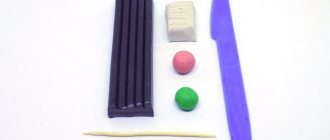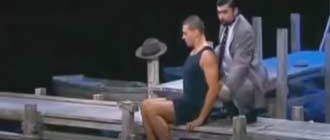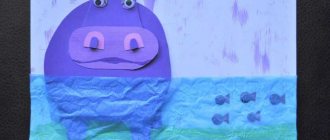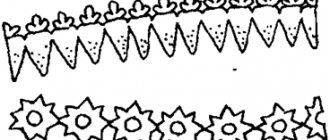Target. Continue introducing children to the LEGO DACTA construction set, the shape of LEGO parts that look like bricks, and options for their fastenings. Start of compiling the LEGO dictionary. Develop the skill of distinguishing parts in a box and the ability to listen to the teacher’s instructions.
Equipment. LEGO bricks from sets.
Progress of the lesson
1. Organizing moment
LEGO friend. Hello guys! Do you already know what it is?
Children. This is LEGO.
LEGO friend. Today we will get to know him further. What did you learn about him in the last lesson?
Children's answers.
Game "Magic Color"
Children sit near a box with LEGO and, on the instructions of a LEGO friend, quickly find bricks of a given color. The tasks can be different, for example, “Who is the first?” Boys quickly find 2 blue bricks, and girls - 2 red ones. Boys find red and yellow bricks, girls find green and yellow, etc.
2. Introduction to bricks
LEGO friend. We have already learned everything about the color of LEGO parts, and now we are learning secrets about their shape. Guys, here are LEGO parts. Look what they look like.
Children. On bricks.
LEGO friend. Are the bricks the same or different in some way? How?
Children's answers.
LEGO friend. Look guys, each brick has these attachments that hold together tightly when you connect them. Think about what you can call them? What do they remind you of?
Children's answers: buttons, wells, buckets, circles, etc.
LEGO friend. Let's count how many buttons there are on LEGO bricks.
Children, together with a LEGO friend, count the buttons on LEGO pieces horizontally and vertically.
Thus, children, together with a LEGO friend, look at 4 types of bricks: 2x2, 2x4, 2x6, 2x8.
LEGO friend. Guys, these are magic good bricks. You and I learned that they are all different, they have buttons that fasten one brick to another. You can play with them and make different buildings. They must be handled very carefully, then you yourself will become wizards.
Brick loves affection!
Then you will build a fairy tale!
3. Graphic exercises
An assignment from a LEGO friend.
Game "Designer"
Children are offered strips of paper of various lengths.
LEGO friend. We will be designers, we will come up with various fastenings of LEGO elements. Draw your options for fastening LEGO parts on these strips.
4. Game to develop orientation in LEGO parts
It is carried out in front of a box with LEGO parts.
LEGO friend. Guys, close your eyes, and now open them. Look what brick I found, name it. Now find him. Who's the first?
5. Introduction to fastening options
Game "Staplers"
LEGO friend. Listen to my task. Take one brick with your right hand. And now with your left hand another brick. What a great fellow you are! Now connect them. Happened? Are your bricks holding tightly? Now think about how else you can fasten two bricks - 2x2 and 2x2, 2x4 and 2x4, 2x2 and 2x4, etc.
In the process of fastenings, which the children try themselves, it is necessary to clarify which fastenings will be the strongest, and which ones will not be very strong, etc. The teacher shows those fastening options that the children could not understand themselves, and be sure to draw attention to the fact that the child I made the discovery myself - a fastening option.
6. Clarification of options for impossible fastenings
Game "Unfastened"
The principle of action is the same as in the game “Staples”, i.e. the children themselves show the options to the teacher or LEGO friend. The speech therapist (LEGO friend) shows those options that the children could not understand on their own, and always pays attention (praise) to the fact that the child himself made a discovery - an option for an impossible connection.
Teacher. A LEGO friend was given a task at a toy factory: to determine how parts should not be fastened together, but he could not solve it. Help him.
7. Classification
It is carried out similarly to the classification of parts by color. Only now children must build towers (walls, stairs, etc.) from LEGO bricks, focusing on size. For example, they build towers with 2x2 bricks, or a wall with 2x4 bricks, etc.
8. Constructive play activities and children's speech development
Teacher. Guys, let's make a gift for our mothers now. But first, let's think about what we will do. A LEGO friend has prepared a new pattern for you.
Analysis of the diagram and children's answers.
9. Bottom line
LEGO friend. You are so great! You played so well and learned so many new things. What else have you learned about LEGO in our magical land?
Children's answers.
Summary of a lesson on Lego construction in the senior group "Park"
Summary of a lesson on Lego construction in the senior group "Park"
Goal: to enrich children’s understanding of the possibilities of constructive materials
.
Objectives: to develop experience in transforming familiar structures
using the techniques of attaching and building on, developing the skills of experimenting with
construction kit
, developing gaming experience, developing accuracy, and the ability to play together according to a given plot.
Materials and equipment: construction
, thematic picture
"
Park "
.
Progress of the lesson:
•Introductory part:
The teacher prepares the structure for playing
(square sheet - the basis for the general construction, attractions (carousel, swing, Ferris wheel, kiosks, figures for playing, blanks for fencing
the park
, collars for decorating the entrance.
Educator: Recently there were days off... Did you relax with your dads and moms... Where (in the park
, went to the theater, on a visit, for a walk, etc.)
. In our city there are many places where children and parents can relax, take a walk... What is depicted in this picture (the panel contains a picture about relaxing in
the park )
. Why did you decide that this is a park
?
How did you find out? What are children doing in the park
?
Why is it nice to relax in the park
?
What has been done in the park
for the recreation of adults and children?
•Main part:
I also built a park
, let's see what I got?
The teacher suggests looking at a pre-prepared design
for completion and for playing out.
What's in the park
? For whom?
The park is a place to relax
, it is always fenced with a beautiful fence, for convenience
there are gates leading into the park
so that you can enter
the park from different sides
, builders are building several gates….
Our park is not completed…
.
What else needs to be done? (gate, fence, paths...)
1.
Look, I made this little fence... — shows the blank….Do you like it? Is the fence comfortable? (low, not elegant)
How can you make a fence high?
Beautiful? Who would like to make a fence for the park
- tall and beautiful?
(some children choose an idea)
.
I also prepared collars - let's see if they are suitable for our park (low and narrow, not decorated)
.
Who can make high and wide collars out of these? Decorate them? (some children choose an idea)
.
also no paths in our park...
.
What paths should be made so that all visitors to the park can walk along them
?
(wide, long)
. Who can make such paths?
Then each subgroup
children take seats on a certain side of the common table.
With each subgroup,
the teacher discusses how
the structures can be changed—added
, built on….
Children create designs
.
The teacher helps to place the structures
. (connect parts of the fence, arrange collars, place paths.
Draws children's attention to what is in the park
not very beautiful - no plants.
additional
Lego
to decorate the park (trees, the teacher makes a flower bed in front of the children (puts a circle of paper, connects two pieces of
the construction set - green and red
, puts them in a circle, children who want to also make flowers.). Now you can invite children and their parents to
the park
?. Choose your family (high and low nesting dolls, human figures made from
Lego
).
•Final part:
Playing with the design
.
(the teacher can join the game by taking on the role of a guide in the park
).
•Conclusion:
What have we decided to build today? What happened? How did you make the long paths? High fence? Wide gate? Why did the park become convenient
?
What did park
?
What did they like best? What else can be built in the park
?
If possible, the design
can be left for children to play with and complete.





